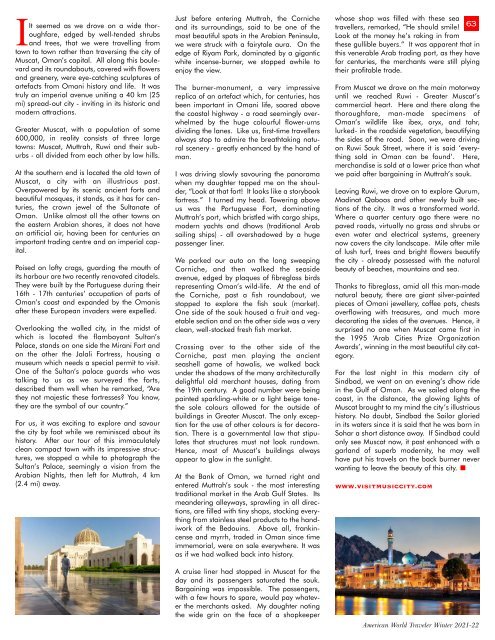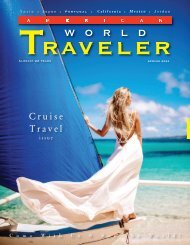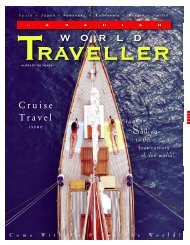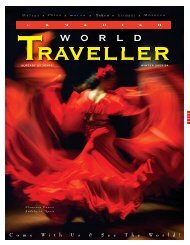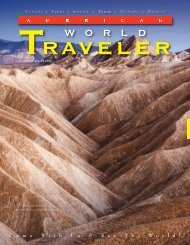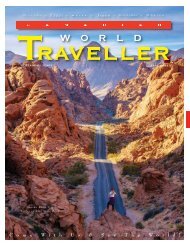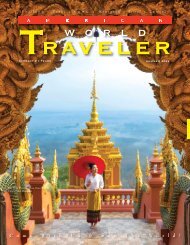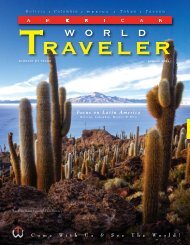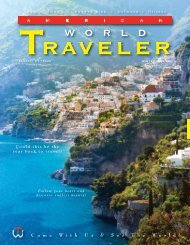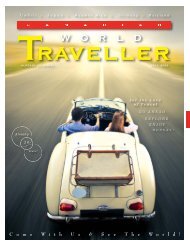American World Traveler Winter 2021-22 Issue
Now in our 20th year of publishing, American World Traveler explores the culture and history of worldwide destinations, sharing the adventure of discovery with our readers and motivating them to make their travel dreams a reality. Published quarterly, AWT helps sophisticated, independent American travelers choose their next destination by offering a lively blend of intelligent, informative articles and tantalizing photographic images from our World’s best destinations, cruises, accommodations and activities to suit every traveler's taste.
Now in our 20th year of publishing, American World Traveler explores the culture and history of worldwide destinations, sharing the adventure of discovery with our readers and motivating them to make their travel dreams a reality. Published quarterly, AWT helps sophisticated, independent American travelers choose their next destination by offering a lively blend of intelligent, informative articles and tantalizing photographic images from our World’s best destinations, cruises, accommodations and activities to suit every traveler's taste.
You also want an ePaper? Increase the reach of your titles
YUMPU automatically turns print PDFs into web optimized ePapers that Google loves.
IIt seemed as we drove on a wide thoroughfare,<br />
edged by well-tended shrubs<br />
and trees, that we were travelling from<br />
town to town rather than traversing the city of<br />
Muscat, Oman’s capital. All along this boulevard<br />
and its roundabouts, covered with flowers<br />
and greenery, were eye-catching sculptures of<br />
artefacts from Omani history and life. It was<br />
truly an imperial avenue uniting a 40 km (25<br />
mi) spread-out city - inviting in its historic and<br />
modern attractions.<br />
Greater Muscat, with a population of some<br />
600,000, in reality consists of three large<br />
towns: Muscat, Muttrah, Ruwi and their suburbs<br />
- all divided from each other by low hills.<br />
At the southern end is located the old town of<br />
Muscat, a city with an illustrious past.<br />
Overpowered by its scenic ancient forts and<br />
beautiful mosques, it stands, as it has for centuries,<br />
the crown jewel of the Sultanate of<br />
Oman. Unlike almost all the other towns on<br />
the eastern Arabian shores, it does not have<br />
an artificial air, having been for centuries an<br />
important trading centre and an imperial capital.<br />
Poised on lofty crags, guarding the mouth of<br />
its harbour are two recently renovated citadels.<br />
They were built by the Portuguese during their<br />
16th - 17th centuries’ occupation of parts of<br />
Oman’s coast and expanded by the Omanis<br />
after these European invaders were expelled.<br />
Overlooking the walled city, in the midst of<br />
which is located the flamboyant Sultan’s<br />
Palace, stands on one side the Mirani Fort and<br />
on the other the Jalali Fortress, housing a<br />
museum which needs a special permit to visit.<br />
One of the Sultan’s palace guards who was<br />
talking to us as we surveyed the forts,<br />
described them well when he remarked, “Are<br />
they not majestic these fortresses? You know,<br />
they are the symbol of our country.”<br />
For us, it was exciting to explore and savour<br />
the city by foot while we reminisced about its<br />
history. After our tour of this immaculately<br />
clean compact town with its impressive structures,<br />
we stopped a while to photograph the<br />
Sultan’s Palace, seemingly a vision from the<br />
Arabian Nights, then left for Muttrah, 4 km<br />
(2.4 mi) away.<br />
Just before entering Muttrah, the Corniche<br />
and its surroundings, said to be one of the<br />
most beautiful spots in the Arabian Peninsula,<br />
we were struck with a fairytale aura. On the<br />
edge of Riyam Park, dominated by a gigantic<br />
white incense-burner, we stopped awhile to<br />
enjoy the view.<br />
The burner-monument, a very impressive<br />
replica of an artefact which, for centuries, has<br />
been important in Omani life, soared above<br />
the coastal highway - a road seemingly overwhelmed<br />
by the huge colourful flower-urns<br />
dividing the lanes. Like us, first-time travellers<br />
always stop to admire the breathtaking natural<br />
scenery - greatly enhanced by the hand of<br />
man.<br />
I was driving slowly savouring the panorama<br />
when my daughter tapped me on the shoulder,<br />
“Look at that fort! It looks like a storybook<br />
fortress.” I turned my head. Towering above<br />
us was the Portuguese Fort, dominating<br />
Muttrah’s port, which bristled with cargo ships,<br />
modern yachts and dhows (traditional Arab<br />
sailing ships) - all overshadowed by a huge<br />
passenger liner.<br />
We parked our auto on the long sweeping<br />
Corniche, and then walked the seaside<br />
avenue, edged by plaques of fibreglass birds<br />
representing Oman’s wild-life. At the end of<br />
the Corniche, past a fish roundabout, we<br />
stopped to explore the fish souk (market).<br />
One side of the souk housed a fruit and vegetable<br />
section and on the other side was a very<br />
clean, well-stocked fresh fish market.<br />
Crossing over to the other side of the<br />
Corniche, past men playing the ancient<br />
seashell game of hawalis, we walked back<br />
under the shadows of the many architecturally<br />
delightful old merchant houses, dating from<br />
the 19th century. A good number were being<br />
painted sparkling-white or a light beige tonethe<br />
sole colours allowed for the outside of<br />
buildings in Greater Muscat. The only exception<br />
for the use of other colours is for decoration.<br />
There is a governmental law that stipulates<br />
that structures must not look rundown.<br />
Hence, most of Muscat’s buildings always<br />
appear to glow in the sunlight.<br />
At the Bank of Oman, we turned right and<br />
entered Muttrah’s souk - the most interesting<br />
traditional market in the Arab Gulf States. Its<br />
meandering alleyways, sprawling in all directions,<br />
are filled with tiny shops, stocking everything<br />
from stainless steel products to the handiwork<br />
of the Bedouins. Above all, frankincense<br />
and myrrh, traded in Oman since time<br />
immemorial, were on sale everywhere. It was<br />
as if we had walked back into history.<br />
A cruise liner had stopped in Muscat for the<br />
day and its passengers saturated the souk.<br />
Bargaining was impossible. The passengers,<br />
with a few hours to spare, would pay whatever<br />
the merchants asked. My daughter noting<br />
the wide grin on the face of a shopkeeper<br />
whose shop was filled with these sea<br />
travellers, remarked, “He should smile!<br />
63<br />
Look at the money he’s raking in from<br />
these gullible buyers.” It was apparent that in<br />
this venerable Arab trading port, as they have<br />
for centuries, the merchants were still plying<br />
their profitable trade.<br />
From Muscat we drove on the main motorway<br />
until we reached Ruwi - Greater Muscat’s<br />
commercial heart. Here and there along the<br />
thoroughfare, man-made specimens of<br />
Oman’s wildlife like ibex, oryx, and tahr,<br />
lurked- in the roadside vegetation, beautifying<br />
the sides of the road. Soon, we were driving<br />
on Ruwi Souk Street, where it is said ‘everything<br />
sold in Oman can be found’. Here,<br />
merchandise is sold at a lower price than what<br />
we paid after bargaining in Muttrah’s souk.<br />
Leaving Ruwi, we drove on to explore Qurum,<br />
Madinat Qaboos and other newly built sections<br />
of the city. It was a transformed world.<br />
Where a quarter century ago there were no<br />
paved roads, virtually no grass and shrubs or<br />
even water and electrical systems, greenery<br />
now covers the city landscape. Mile after mile<br />
of lush turf, trees and bright flowers beautify<br />
the city - already possessed with the natural<br />
beauty of beaches, mountains and sea.<br />
Thanks to fibreglass, amid all this man-made<br />
natural beauty, there are giant silver-painted<br />
pieces of Omani jewellery, coffee pots, chests<br />
overflowing with treasures, and much more<br />
decorating the sides of the avenues. Hence, it<br />
surprised no one when Muscat came first in<br />
the 1995 ‘Arab Cities Prize Organization<br />
Awards’, winning in the most beautiful city category.<br />
For the last night in this modern city of<br />
Sindbad, we went on an evening’s dhow ride<br />
in the Gulf of Oman. As we sailed along the<br />
coast, in the distance, the glowing lights of<br />
Muscat brought to my mind the city’s illustrious<br />
history. No doubt, Sindbad the Sailor gloried<br />
in its waters since it is said that he was born in<br />
Sohar a short distance away. If Sindbad could<br />
only see Muscat now, it past enhanced with a<br />
garland of superb modernity, he may well<br />
have put his travels on the back burner never<br />
wanting to leave the beauty of this city.<br />
www.visitmusiccity.com<br />
<strong>American</strong> <strong>World</strong> <strong>Traveler</strong> <strong>Winter</strong> <strong>2021</strong>-<strong>22</strong>


